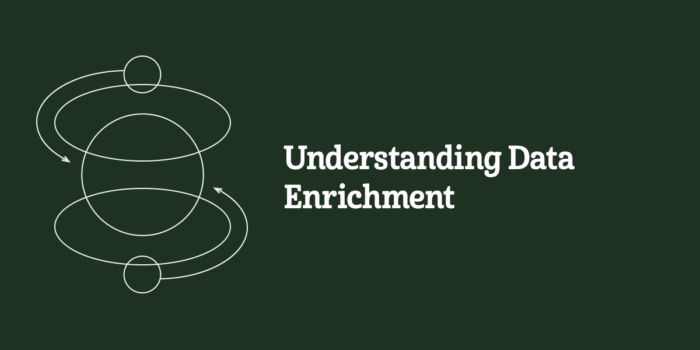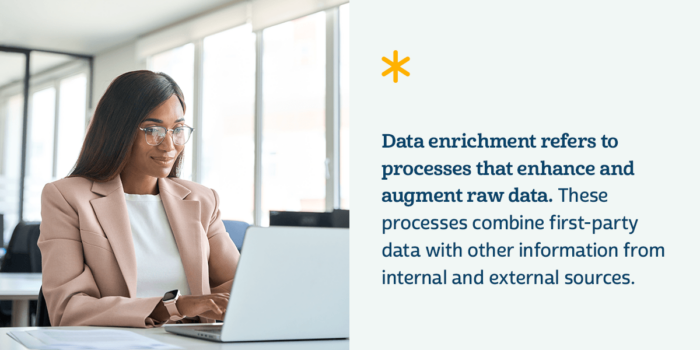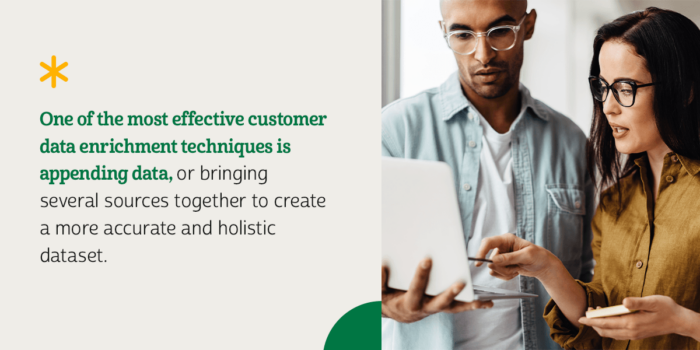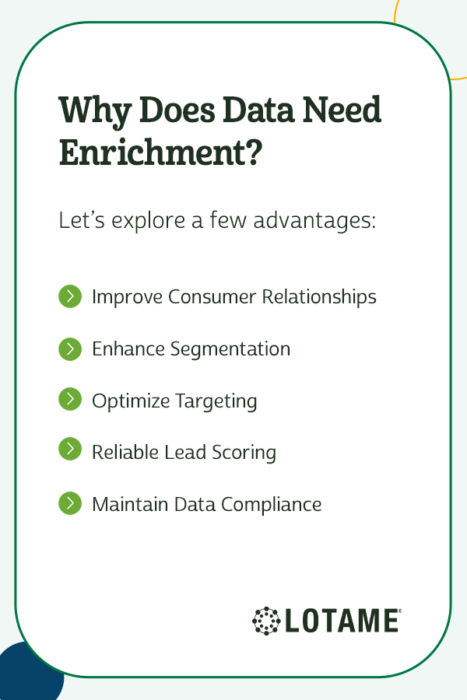
- What is Data Enrichment
- The Types of Data Enrichment
- Data Enrichment Techniques
- Why Does Data Need “Enrichment”?
- Data Enrichment Solutions for the Future
Consumers have abundant choices, making it harder for your brand to stand out, let alone connect with people who would be interested in your product. Data drives sales and the customer experience, but you need more than your first-party data alone to get the insights you need to target your ideal customer base and set yourself apart from the competition. Data enrichment is important because you can use it to get the quality information your company needs.
What Is Data Enrichment?
The meaning of data enrichment refers to processes that enhance and augment raw data. These processes combine first-party data with other information from internal and external sources. Enrichment tools then apply organization and insights to develop more accurate and detailed information about a company’s customer base. So, how does data enrichment work, and how can you do it?

Data enrichment begins by collecting information from multiple sources, including these three types.
- First-party data: First-party data is the information you collect directly from your customers is. An example includes email addresses and phone numbers gathered from the contact form on your website and stored in your customer relationship management platform. First-party data can also come from subscription lists, social media analytics and customer surveys.
- Second-party data: Second-party data is another organization’s first-party data. You can combine this information with your first-party data with the help of a data collaboration platform to increase its scale and target customers more accurately. Second-party data is particularly valuable for reaching a new demographic that represents a significant portion of the source company’s customer base.
- Third-party data: Third-party data is first-party data aggregated and compiled from many sources. Instead of buying second-party data from another organization, a company can purchase datasets from aggregators to enrich and scale up their first-party information.
All three types of data can be effective for better understanding and targeting your ideal audience. While first-party data is typically the most valuable because it is information directly collected from your customers, it doesn’t always provide enough scale. Enhancing that data using second- and third-party data helps provide a more panoramic view of your audience. To take enrichment even further, you can apply analytics to uncover patterns and identify valuable insights.
By combining data through enrichment techniques, brands can gain deeper insights into their customers’ preferences and behaviors. Your company can leverage data enrichment to make informed decisions, expand your customer base and personalize your messaging for new heights of success. Organizations increasingly use this tactic to achieve their long-term marketing goals.
The Types of Data Enrichment
While there are as many types of data enrichment as there are data sources, companies tend to rely on a few prevalent approaches.
Demographic
Demographic data enrichment enhances customer datasets by applying information like marital status, family size, income level and credit rating. These details enable granular personalization for your targeting criteria, messaging and creativity.
Geographic
Geographic data enrichment involves adding location information to customer profiles, including ZIP codes and mapping insights. Geographic details are particularly beneficial for mobile advertising, setting localized pricing and determining where to place new store locations.
Behavioral
Behavioral data enrichment applies customer behavioral patterns to their profiles, including their purchases and browsing behaviors. This method often involves monitoring a user’s purchasing path to identify primary areas of interest for each customer. Behavioral data is essential for companies to determine what advertising campaigns work best and what each campaign’s return on investment will be.
Data Enrichment Techniques
There are six techniques used in the data enrichment process.
1. Data Segmentation
Dividing data into different groups is segmentation, a crucial part of marketing data enrichment. You can segment your data differently based on your goals and the variables you are working with.
These are some commonly used examples of data segments.
- Geographic: Categorizing data based on state, city, county, etc.
- Demographic: One of the most helpful ways to enrich customer data, this segment derives from attributes like age, gender, income, occupation, marital status, number of children, etc.
- Behavioral: You can also segment consumer data based on spending habits, browsing history, order habits, consumption habits, session frequency, time spent on a website, etc.
- Technographic: Technographic segmentation depends on technological preferences like mobile devices, favorite browsers, software and other behavior.
- Psychographic: Attitudes, interests, values, personalities and archetypes are common psychographic segment criteria.
2. Data Imputation
Missing information can significantly detract from your marketing efforts, making it more challenging to effectively work with the data on hand. Data imputation is a type of data enrichment that substitutes missing data and fields with another value instead of removing it from the system.
By using these substitutions to indicate missing data, bias or baseless assumptions are less likely to affect your conclusions. These are some examples of data imputation techniques commonly used to substitute missing data.
- Fixed values: Fixed-value imputation involves replacing the missing data with preset fields or values. For example, using “did not answer” in survey results means the information associated with this question or field is unavailable. The system will apply this substitute answer to all missing fields, making it easier to work with the dataset.
- Most frequent value: This popular technique replaces missing data with the most commonly occurring value in a column. It’s an effective imputation technique that works with numerical and nominal data.
- Nearest neighbor: The nearest-neighbor technique is when the system substitutes missing data with the value of the most common feature in the data group or segment.
- Next or previous value: This method is good for data collected over time, like ordered or time-series data. It swaps missing information with the nearest value within the time series.
3. Appending Data
One of the most effective customer data enrichment techniques is appending data, or bringing several sources together to create a more accurate and holistic dataset. An example is combining customer information from your marketing, customer relationship and financial teams into one giant dataset. Appending data is beneficial for audience and sales data enrichment.
Including data from a third-party source is also part of appending data. Merging third-party data can be vital, as you can compare results and draw better insights. The more data you have to work with, the easier it will be to understand a subject or audience.

4. Derived Attributes
Derived attributes are fields or values you can infer from other attributes within a dataset. For example, your company might not store age as a value in your database, but you can calculate this information based on a customer’s birthdate. The ability to improve data integrity by keeping information up to date makes derived attributes invaluable.
Here are some typical derived attributes.
- Total sales: Determine this value by calculating the sum of all sales made by a specific customer or salesperson.
- Time between: Use date and time fields to calculate relevant intervals — for example, the turnaround between a purchase and response.
- Conversions: For example, converting hours into days, weeks or months makes it easier to use time-bound data.
- Order classifications: Product category and product age are derived attributes you can use to sort and organize data more effectively.
- Dimensional counts: Counting values within a dataset can inform specific counter fields, letting you create practical comparative fields. For example, you can compare a consumer who frequently purchases cosmetics to someone who buys many tech products. Learn what differentiates them and develop marketing strategies based on that information.
5. Data Categorization
Data categorization involves labeling unstructured data for better organization and analysis. There are two prominent types of data categorization used for enriching data.
- Topication: Topication is determining the topic covered by text or data — for example, prices, news, sports, entertainment, etc.
- Sentiment analysis: You can extract emotions from data points to analyze customer feedback, categorizing their responses into positive, angry, neutral, negative or relaxed.
6. Entity Extraction
Entity extraction is similar to data categorization because they both deal with unstructured data. The difference is that entity extraction involves teasing out useful, structured data from unstructured data. You can use entity extraction to identify places, organizations, concepts and places based on information like dates, currency and phone numbers.
Here are some widespread uses of entity extraction.
- Finding and matching job candidates: Recruitment companies and human resources departments can find ideal job candidates using entity extraction. By reading through and extrapolating information from resumes, online profiles and other documents, they can find attributes and qualifications that match job descriptions in their database.
- Data enrichment solutions: B2B data enrichment solutions use entity extraction to give clients helpful information hidden within their provided datasets, leading to the creation of new categories and insights about how to use customer information.
- Content recommendations: Extracting and organizing information about users based on their browsing history and interests allows you to give them better recommendations.
Each type of data enrichment helps a company meet different business goals. Before selecting the right data enrichment technique for your business, identify the kind of information you need.
Why Does Data Need “Enrichment”?
The primary advantage of data enrichment is the improved value and accuracy of your company’s customer understanding or view. Companies need high-quality data to make essential business decisions and draw valuable conclusions. 
If you are considering data enrichment, you may wonder why you need to use more than first-party data collected from CRM platforms, websites, surveys and subscription lists. While information sourced directly from your existing customer base is valuable, it can also have limitations. First-party data tells companies about their visitors’ behaviors within their site(s) or app(s), but it provides no information about consumers’ lives outside their company’s scope — like purchasing decisions and website activity.
Even if your company collects demographic and geographic information, your observation of each customer depends solely on how they behave when interacting with your company, which only shows a sliver of who they are. Less detailed insights might not give your business all the information it needs for accurate and effective marketing.
By supplementing your company’s information with second- and third-party data, you can gain a fuller picture of who your customer is so you can more accurately understand and target them. Then, you will also have more information to apply analytics for increasingly meaningful insights.
On top of eliminating the limits of first-party data, using data enrichment can offer significant benefits in various business-critical areas. Let’s explore a few of these advantages.
1. Improved Consumer Relationships
When a customer feels like your company understands their needs, it makes them more likely to make a purchase and continue working with your business in the future. Data enrichment can facilitate this enhanced understanding of customers, providing more information to enable a more personalized experience.
Enriched data allows you to tailor your business to general or highly specific information, all based on the details within your dataset. You can adjust your business’ pricing and advertising efforts to appeal to a target demographic. You can also create more personalized communications based on an individual customer’s data.
These personalized experiences are highly valuable for consumers, fostering meaningful, long-term relationships that translate into business success. In one Forbes survey, 40% of business executives reported that customer personalization had a direct positive impact on their sales.
2. Enhanced Segmentation
The more data you have, the more accurately you can segment your audience. Segmentation based on large- and small-scale determiners helps categorize customers to see what they have in common. This knowledge allows your company to develop more effective targeted campaigns. With more data, you can reveal new patterns and marketing or product opportunities that may have been invisible before.
3. Optimized Targeting
The spray-and-pray approach to marketing may help general brand awareness, but its effectiveness at closing a customer is less clear. Instead, targeted marketing is where most companies focus their efforts. However, targeting buyers with personalized advertisements requires businesses to have a complete picture of their audience.
While first-party data can only show how consumers behave when interacting directly with a company, augmenting this data with second- and third-party data allows organizations to get a panoramic view of each consumer and their digital life. Doing this helps businesses identify and focus their efforts on potential customers who are most likely to convert.
4. Reliable Lead Scoring
Evaluating and scoring leads helps sales teams prioritize their efforts, but it is nearly impossible to do when you have incomplete customer profiles. Data enrichment can enhance customer profiles with quality data, enabling reliable and meaningful scoring. The data’s quality and depth can also enable automated lead scoring, removing the guesswork and allowing your sales team to focus on their goals.
5. Maintained Data Compliance
Data enrichment processes ensure your company’s compliance with data privacy regulations. Many laws impose limits on what type of customer data you can store and how long you can keep it, and you must also maintain do-not-call lists. If your company doesn’t maintain compliance, you could face costly penalties.
On the other hand, you can establish data enrichment processes to regularly scrub databases, safely storing valuable data while keeping your business compliant.
6. Enhanced Data Quality
Redundant and inaccurate data can result in wasted advertising dollars, customer dissatisfaction and incorrect analytics, which costs companies significantly. Many businesses operate with redundant data because they are either unaware of its existence or unsure of what data to remove.
Data enrichment tools can eliminate redundant and inaccurate data by automatically analyzing information, combining duplicate entries and correcting errors while maintaining updated profiles. This method enhances the quality of a company’s data so they can be confident they are working with the most accurate and up-to-date information possible.
7. Improved Cost Savings and Sales
Data enrichment reduces costs and optimizes sales. Data enrichment protocols save companies money by managing existing information, which ensures you’re not wasting database storage on data that isn’t useful to your business. This process also reduces costs by minimizing penalties due to data noncompliance. Simultaneously, data enrichment maximizes profits by boosting sales through more effective marketing and customer management. It can identify cross-selling and upselling opportunities while promoting meaningful customer relationships.
Data Enrichment Solutions for the Future
Data collection is changing, and third-party tracking is falling out of favor. Without third-party cookies, companies will have to look to partners with future-proofed data enrichment solutions. While most data enrichment solutions rely on cookie-based data, many options are ready for the new future of digital advertising. One such solution is Lotame’s end to end data collaboration platform Spherical , which enriches customer data through identity powered activation.
Watch this demo to learn more about how Spherical can help you enrich and accelerate your data – whether you have it or need it.
Develop rich data about your customers and uncover more opportunities for engagement — no cookies required. Contact us today to learn more about Lotame’s Spherical Platform.